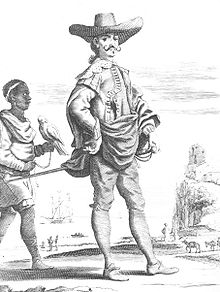Hidalgo (nobility)

Hidalgo [ iˈðalɣo ] has been called since the Middle Ages in Spain the nobility from ancient Christian families without a special title. The word is a modification of hijo de algo , meaning "son of [a family with] property". algo is modified from the Latin aliquod "something". This regionally very numerous population group - in parts of northern Spain at times up to 90% of the inhabitants were Hidalgos - was called hidalguía and mostly lived in modest circumstances. The corresponding counterpart in Portugal is the Fidalgo (from filho de algo ).
A distinction is made between Hidalgos de sangre - born, and Hidalgos de privilegio - from whom the nobility was won or bought by grace. With regard to state rights, Hidalgos used to stand in line with the Caballeros ( knights ) and Escuderos (shield-bearers or nobles in the service of a great man).
Hidalgos played a key role in the 8th to 15th century Reconquista (recapture) of the Iberian Peninsula against the Muslim conquerors. After the discovery of America , many later sons traveled to the New World as conquistadors and took part in the conquest, sacking and settlement of America during the 16th and 17th centuries. From this origin, the Hidalgo derived that any form of manual work was "dishonorable" for him, according to which a Hidalgo was only allowed to get his hands dirty on the blood of the enemy. From this, Spanish and Latin American authors have on various occasions inferred that their countries are lagging behind in development. So wrote Sérgio Buarque de Holanda : "Doing nothing is worthy but have always been desirable to Iberians than the thankless struggle for daily bread."
However, regional exceptions were also allowed from the rule that Hidalgos were not allowed to practice any craft, since in parts of Spain the population consisted almost entirely of Hidalgos. For the frequently targeted by commoners with zeal ennobling but prior industrial activity was an exclusion criterion, for example, had to Diego Velázquez in the process of his inclusion in the peerage evidence put forward that he had never sold a painting, which was not true by the way.
The fictional character Don Quixote by Miguel de Cervantes represents a parody of the knighthood of the Hidalgos, which was considered outdated towards the end of the 16th century .
In ordinary life the Hidalgos are called by their first name, which is preceded by the title Don or Doña . From the 18th century onwards, Don was also used as an address for wealthy middle-class people. Although Spain is currently a monarchy, the untitled nobility, i.e. the Hidalgos, are not subject to any direct state control. The descendants of the Hidalgos are nevertheless united in the Royal Spanish Aristocracy Corporation, the Real Asociación de Hidalgos de España , which monitors compliance with historical nobility law . The members are personally listed in a nobility register . This aristocratic association is a member of the umbrella organization of the European aristocratic associations ( CILANE ).
Web links
Individual evidence
- ↑ a b c d Peer Schmidt et al .: Brief history of Spain . In: Peer Schmidt (ed.): Universal library . No. 17039 . Reclam Verlag, Stuttgart 2002, ISBN 3-15-017039-7 , p. 232 f .
- ↑ a b c Remo Rey: History of Latin America from the 20th century to the present . In: Beck's series . No. 1675 . Verlag CH Beck, Munich 2006, ISBN 978-3-406-54093-6 , p. 197-202 (quoted there from: Sérgio Buarque de Holanda: Raízes do Brasil . Editora José Olympio, Rio de Janeiro, 1975. pp. 9-10).